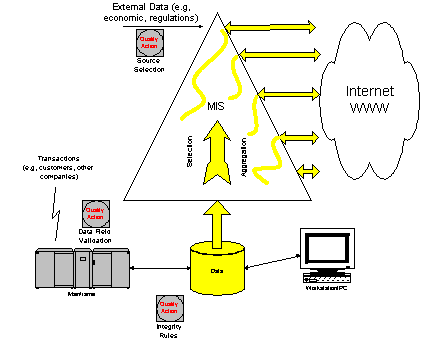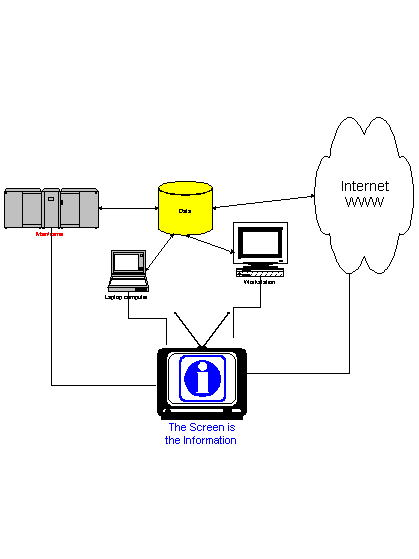 Figure 1: Quality
Improvement Points
Figure 1: Quality
Improvement Points Figure 2: Quality Improvement Points
(Detailed)
Figure 2: Quality Improvement Points
(Detailed)
Abstract
This short position paper addresses some issues related to the practice of information quality improvement and the impact of the Internet and WWW related technologies on it. This impact is direct as well as indirect, positive as well as negative. The discussion also implies a general framework for devising quality improvements techniques and practices.
The subject of information and data quality
has been receiving significant attention in the last couple
of years as a result of the increased importance and value of
information for competitive. advantage . Major technological
developments in the areas of communication, personal computing,
databases, and CASE tools have led to both problems and opportunities.
By making systems easier to develop, data easier to distribute
and replicate, and by providing end-users with powerful desktop
tools, data have proliferated in an "unmanaged" manner
; the same technologies, however, also provide the capability
to improve data quality. In order to deal effectively with the
issue of information quality it is important to:
The above points ( they can also be viewed
as steps to be taken ) are quite intuitive but often not practiced.
There has been significant work on defining quality dimensions
(e.g., [6],[8]). While all the dimensions that have been identified
are important, some of them are not intrinsic properties
of the data, e.g., believability or accessibility; this is not
to say that those factors are unimportant, but that there are
probably other mechanisms (rather than improving the quality of
the data) that can improve them. It is important to separate
the different aspects associated with data (such as intrinsic
properties, and capture and delivery systems). The information
flows and processes map is a good mechanism not only to do that,
but also to separate causes from symptoms. A particular quality
dimension may not be relevant in some contexts. For example, inconsistent
data from multiple sources is generally considered a data quality
problem where a common recommendation is to capture the data using
a single source; this of course will not make sense in intelligence
applications where data has to be gathered from multiple sources,
and inconsistency does not necessarily mean bad data.
Defining the quality dimensions explicitly is important both for
communication and management purposes. Similar to information
modeling we have to make sure that we mean the same thing when
we use the term "data quality". The explicit dimensions
facilitate the prioritization of actions taken to improve data
quality as well as quality monitoring
Identifying the flow of data and the processes that effect it is extremely important as it helps in identifying those points where quality is susceptible to degradation, and where quality enhancement actions should take place. A very simplified diagram is introduced in Figure 1; D1 through D7 are common stages which data undergo; some may not be applicable for certain applications, and typically there is significant cycles which are not shown in the diagram (e.g., data in D6 is placed back in the database rather than displayed). .In practice a data item may go through a process type multiple times, e.g. it is captured, processed, distributed, processed again, distributed again, and so on. The diagram is not a system flow. The oval shapes indicate crucial steps that significantly effect data quality (with respect to all its definitions in the references ); some of their instantiations are shown in Figure 2.
The quality dimensions are orthogonal to those processes. This
enable one to examine a quality problem in a structured way by
first defining the problematic quality aspects, separate symptoms
from causes, and examine the cause where it occurs (any place
in D1 through D7). For certain quality dimensions, the improvement
points can be confined; for example, the quality dimensions of
the conceptual view are impacted only in D1 (primarily) and D2
since they don't deal with the data instances. Data currency
(or timeliness) for example can be impacted by several processes
(D1 if it specifies currency requirements, and D3 through D6).
 Figure 1: Quality
Improvement Points
Figure 1: Quality
Improvement Points Figure 2: Quality Improvement Points
(Detailed)
Figure 2: Quality Improvement Points
(Detailed)The above discussion and the diagrams assumed. a managed data processes. These processes determine the boundaries of the managed system. The big problem: data can leave and enter those boundaries in an unmanaged way. For example, data is extracted from a database into a spreadsheet, manipulated in various stages and then used to update the database; that loop may be subject to poor quality control. The problem is that the traditional lines of demarcation between users and IS have become increasingly blurred. The Internet and the WWW only makes this more prevalent and complicated (see discussion below
The advances in communication and computing technologies coupled
with cross-functional business integration have changed information
flows dramatically. Figure 3 illustrates the traditional information
flows. Most of the organizational data was captures or generated
by transaction systems, totally under the control of a centralized
IS department, and then moved up the organization in the forms
of reports (typically aggregation and classification of the lower
level data). External data, about the business environment, entered
the organization at a higher (decision making) level. Conceptually,
identifying the quality control points was relatively easy (though
often not practiced): for external data, the only choice was source
of data, and for internal data, the transaction systems, databases,
and the report- producing systems.
 Figure 3: Traditional
Information Flows
Figure 3: Traditional
Information Flows
The proliferation of personal computing and Internet usage have
changed the information flows, increasing the "unmanaged"
flows dramatically, as illustrated in Figure 4. While information
quality procedures improved for the transaction generated data
(primarily due to increased use of electronic capturing and exchange
of data, and integrity rule support by DBMS technology), serious
quality problems arose for ad-hoc information generated from
various sources, such as external Web sites and individual users'
personal computing applications.

One of the consequences of the emerging technologies is a mix of new data types that are not your traditional database types. They include HTML, SGML, EDI, MIME (and plain e-mail). These new types and their related technologies add significant complexity to the function of Data Administration and require changes to traditional definitions (at the database level) of data items quality.
A new generation of technologies have an interesting impact on information quality (broadly defined). These emerging technologies, which can be termed "screen control" are targeted towards improved user's productivity by providing intelligent screen capture and manipulation tools (see Figure 5). An example is technology developed by AnySoft [1], that in general consists of three components:
Besides increased productivity, this technology is related to information quality in the following ways. It can significantly improve the presentation and usability dimensions, and it can be used to control the display of contents. On the other hand, like many other technologies, if not managed it can introduce quality problems with respect to source tagging or identification, since newly generated information can originate from screen displays rather than from applications. It turns out that this technology itself can provide the ability to trace and manage an important class of information flow -- the information that "passes through" the screen.
 Figure
5: The "Screen is the Information" Concept
Figure
5: The "Screen is the Information" Concept
This paper emphasized the importance of identifying information
flows and processes patterns in an organization - a prerequisite
for managing information quality. It presented the notion of managed
information flows and processes vs. unmanaged ones. Many of the
proposals for information quality improvements assume the "managed"
case. Unfortunately, a significant, and increasing, portion
of the information flows and their processing is unmanaged. The
Internet, WWW, distributed desktop computing, and screen capture
and processing technologies, will make the situation worse, unless
more of the flows become managed.
The good news is that the same technologies can be used to improve
various data quality dimensions. WWW applications (both Internet
and Intranet) reduce the amount of paper work and the number of
steps involved in data capture; they also provide for direct input
of the data by their "owners", e.g., customers change
their address directly through the Web. Screen control technologies
can be used in dual mode, on one hand providing the user with
an ad-hoc mechanism to manipulate data in ways that pre-built
systems would not allow, and on the other hand provide an administrative
control that can be used to better control information quality.
More research is needed in several areas. Source tagging and process tracing are crucial; database schemes on their own can't be totally effective, and integration with other non-database technologies is essential; any resulting scheme should make sense with respect to organizational information quality processes. Allowing user choices in data retrieval ( see [4] for example) can lead to higher-quality information in cases where the "common wisdom" calls for consistency resolution at the source (or as close to the source as possible). Measuring the quality of new data types (such as multi-media objects) is also an important area; obviously, a range check, such as in salary value validation, is not appropriate here. And finally, though not addressed explicitly in this paper, resolving data heterogeneity is a fundamental problem is data quality, and a more difficult one in the context of the WWW.
References
[1] AnySoft Office tools; AnySoft Inc., Cambridge, Massachusetts, 1996.
[2] Ballou, D. P. and K. G. Tayi. Methodology for Allocating Resources for Data Quality Enhancement. Communications of the ACM. 32(3) 1989. pp. 320-329.
[3] Ballou, D. P., R. Y. Wang, H. Pazer and K. G. Tayi. Modeling Information Manufacturing Systems to Determine Information Product Quality Management Science (forthcoming). 1996.
[4] Gal A., Etzion O., and Segev A. Representation of HighlyComplex Knowledge in a Database. Journal of Intelligent Information Systems, No. 3, pp. 185-203, 1994.
[5] Liepins, G. E. and V. R. R. Uppuluri, ed. Data Quality Control: Theory and Pragmatics. D. B. Owen. Vol. 112. 1990, Marcel Dekker, Inc.: New York. 360 pages.
[6] Redman T.C. Data Quality - Management and Technology, Bantam Books, 1992.
[7] Wand, Y. and R. Y. Wang. Anchoring Data Quality Dimensions in Ontological Foundations. Forthcoming, Communications of the ACM. 1995.
[8] Strong, D. M., Y. W. Lee and R. Y. Wang. Data Quality in Context. Forthcoming in Communications of the ACM. 1996. .
[9] Wang, R. Y. and H. B. Kon, Towards Total Data Quality Management (TDQM), Information Technology in Action: Trends and Perspectives, R. Y. Wang, Editor. Prentice Hall: Englewood Cliffs, NJ. 1993.
[10] Wang, Y. R. and S. E. Madnick. A Polygen Model for Heterogeneous Database Systems: The Source Tagging Perspective. Proceedings of the the 16th International Conference on Very Large Data bases (VLDB). Brisbane, Australia: pp. 519-538.
[11] Wang, R. Y., V. C. Storey and C. P. Firth. A Framework for Analysis of Data Quality Research. IEEE Transactions on Knowledge and Data Engineering. 7(4) 1995. pp. 623-640.